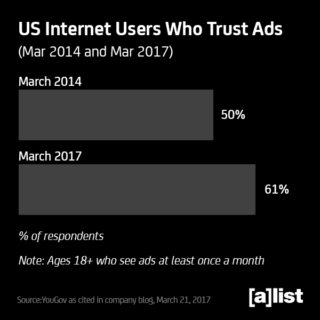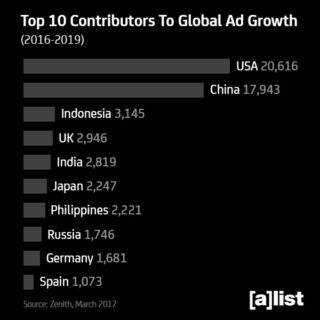This week, we get a glimpse into upcoming holiday plans, internet ad spending and which streaming services reign supreme.
Hopping To The Store
Easter is April 15th, and the National Retail Federation (NRF) has predicted record spending for the spring holiday. Americans who observe Easter will spend $18.4 billion, NRF predicts, a six percent increase over last year. 2017 is expected to see the highest average spend per person—around $152—since the NRF started tracking Easter spending 14 years ago.
Of everything consumers plan to buy, around $5.8 billion will be spent on food and $2.6 billion on candy. Fifty percent of respondents said they plan to buy clothing, up from 45 percent last year—the highest percentage in a decade. Department stores will be pleased to hear that 46 percent of Easter observers in the survey intend to shop there, up from 41 percent a year ago.
Advertising Trust
 Internet users in the US trust advertisements more than they did two years ago, according to YouGov. The company’s March 2017 survey asked internet users who see ads at least once a month if they trust the advertising they see, read or hear. Sixty-one percent of respondents said they do, compared to 50 percent in 2014. YouGov found that in addition to being more trusting of advertising, 72 percent of respondents said they feel the ads they encounter are “honest.”
Internet users in the US trust advertisements more than they did two years ago, according to YouGov. The company’s March 2017 survey asked internet users who see ads at least once a month if they trust the advertising they see, read or hear. Sixty-one percent of respondents said they do, compared to 50 percent in 2014. YouGov found that in addition to being more trusting of advertising, 72 percent of respondents said they feel the ads they encounter are “honest.”
Streaming Satisfaction
There are many streaming services to choose from, but Netflix and Spotify deliver the best customer experience, according to the 2017 Temkin Experience Ratings, based on a survey of 10,000 US consumers. Out of the top 16 streaming media companies, Netflix and Spotify tied for the top spot with a score of 74 percent, followed by Amazon Prime Instant Video and Pandora, tied at 73 percent.
For the first time ever, streaming music services were responsible for more than 50 percent of all US music industry revenue in 2016, according to a report by the Recording Industry Association of America (RIAA). Revenue from paid subscription plans brought in $2.5 billion, with an average of 22.6 million US consumers subscribing to streaming services last year—more than doubling from 2015.
Safe or Cheap?
 When it comes to advertising, do you get what you pay for? That may be the case with programmatic ad spending, particularly when those ads appear on YouTube. Several brands have pulled their advertising campaigns from YouTube after finding their ads had appeared next to extremist content. Enders Analysis compared the cost of advertising on the platform, as obtained through several outlets. Higher priced ad placement such as YouTube Preferred offers more control over where ads appear, but most advertisers simply buy YouTube ads at scale, via ad exchanges like Google’s AdX.
When it comes to advertising, do you get what you pay for? That may be the case with programmatic ad spending, particularly when those ads appear on YouTube. Several brands have pulled their advertising campaigns from YouTube after finding their ads had appeared next to extremist content. Enders Analysis compared the cost of advertising on the platform, as obtained through several outlets. Higher priced ad placement such as YouTube Preferred offers more control over where ads appear, but most advertisers simply buy YouTube ads at scale, via ad exchanges like Google’s AdX.
“The basic idea of ‘you get what you pay for’ in programmatic video advertising, either in media costs or agency planning and service fees (or both, depending on the type of media), is something we believe that many advertisers have yet to fully incorporate into their strategy for media buying,” said Enders Analysis research analyst, Matt Littunen.
Overall, Global internet advertising expenditure will grow 13 percent to reach $205 billion in 2017, according to Zenith’s new Advertising Expenditure Forecasts. The updated forecast projects that the US will contribute 28 percent of worldwide ad expansion through 2019 and the fastest-growing component of internet ad spend will be social media, which will grow at an average rate of 20 percent a year to reach $55 billion by 2019.
